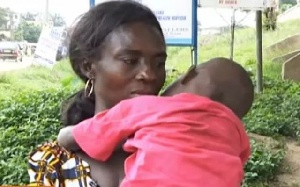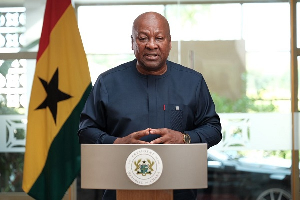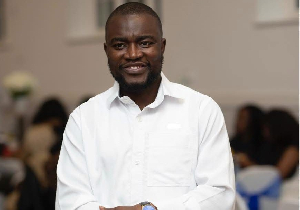Pressure group, OccupyGhana, in response to the recent case of defilement against a 4-year-old girl has said even though they sympathize with the victim’s family, the suspect should not be judged by the public and is innocent until a court of law finds him guilty.
In a press statement, the group questioned reports of the series of events before and after the alleged defilement and noted that before a person is convicted there is the need for solid evidence.
“We condemn without reservation sex abuse in general and Child Sex Abuse in particular. However, we also believe in being innocent until proven guilty by a competent law court. The court of general opinion has already found 17 or 18-year old ‘Kwabena’ guilty. We do not have the luxury to support that position until, it has been so proved by the prosecution in a competent law court. For there to be a conviction, there must be good evidence gathered by the authorities to hold up in court, and like with all evidence, the earlier collected, the better,” the statement read.
They digested reports from key players involved in the case and said there is little coordination with the stories coming up and needed deeper investigation adding that there was no way to ascertain the victim’s mother’s story of reporting to their chief after the incident occurred since the chief denied that allegation.
“The mother of the victim is alleged to have reported the matter to the chief, who is said to have pronounced the suspect innocent on the instructions of the gods. The chief has denied this. The victim’s father is also said to have reported the case to the police. There is very little to that part of the story,” they mentioned.
In the statement they also suggested that the case had several loopholes that needed to be addressed, saying, "this particular case, presents more questions than answers:
1. Apart from the 8-year old sister, was there an adult child keeper?
2. If there was such a keeper, what did she do about it before the victim’s mother returned from the funeral?
3. From the media, the victim’s mother reported after several days of bleeding, why was that so?
Was it that the child refused to talk? Was she afraid? Was the mother also afraid?
4. Did the mother confide in another person prior to reporting the case? If she did, what did the person advise?
5. The victim’s mother is said to have reported to the chief of the village, can this be corroborated?
6. If she did report to the chief, what exactly did the chief advise?
7. Did the chief say he had consulted the oracles who declared the suspect innocent?
8. Was there another person present when the victim’s mother met the chief? We know that per our customs, there is usually a linguist at least, when the chief holds court.
9. Has the chief been invited by the police for questioning? If he did not advise the lady to report the case, nor did not report same to the police, can we say he obstructed justice?
10. Has the suspect been questioned by the police?
11. Has the suspect been examined by the doctor?
12. How authentic is the medical report doing the media rounds?
13. Is it possible for a rape victim not to have physical clinical evidence of rape?
They maintained that sexual assault of any kind was wrong and not to be accepted and wished the 4-year-old victim quick recovery.
“Our hearts still go out to the little girl because she is unwell and has been admitted to hospital. Parents should love and encourage their children to communicate with them without fear, so that the children are able to report any form of abuse. Finally, the community should not shield offenders,” they noted.
Below is the full statement from OccupyGhana
7th NOVEMBER 2017
OCCUPYGHANA® PRESS STATEMENT
OCCUPYGHANA® STATEMENT ON THE REPORTED DEFILEMENT OF A MINOR AT ASSIN ADADIENTEM AND MATTERS ARISING
BACKGROUND
Two weeks ago, we woke up to media reports, alleging that a 4-year old girl had been sexually abused in Assin Adadientem in the Central Region. This allegedly took place on 13th October 2017. The age of the suspect, named only as “Kwabena.” varies between 17 and 18 years, depending on which source you are getting the information from.
The mother of the victim is alleged to have reported the matter to the chief, who is said to have pronounced the suspect innocent on the instructions of the gods. The chief has denied this. The victim’s father is also said to have reported the case to the police. There is very little to that part of the story.
According to one article on ‘myjoyonline’, she bled profusely for days before her mother sought help. According to one report, the victim’s mother had travelled to a funeral and had left her in the care of her 8-year old sister, a report that ought to be seriously investigated.
That narrative, and given the fact that the mother detected the bleeding on the 14th of October, suggests that the mother was away for at least one night. Even though the article did not specify the bleeding site, we will assume that it was from the area of the vagina, considering the circumstances.
According to another Joy FM report, Dr. Bernard Brew at the St. Francis Xavier Hospital in Assin Fosu, issued a medical report showing an intact hymen with no evidence of laceration; the vulva however was moist and appeared inflamed.
These events are not unusual when it comes to matters involving child sexual abuse. The stories are hardly ever straightforward and it takes a lot of time, patience, training and commitment to sieve through the available evidence.
We condemn without reservation sex abuse in general and Child Sex Abuse in particular. However, we also believe in being innocent until proven guilty by a competent law court. For there to be a conviction, there must be good evidence gathered by the authorities to hold up in court, and like with all evidence, the earlier collected, the better. A delay usually leads to contamination and unreliability of the evidence, if any.
The court of general opinion has already found 17 or 18-year old ‘Kwabena’ guilty. We do not have the luxury to support that position until, it has been so proved by the prosecution in a competent law court. If ‘Kwabena’ is under the age of 18 years, he would be treated as a juvenile.
That would mean that this matter would fall squarely within the remit of the 2003 Juvenile Justice Act, which has very different considerations as regards offences committed by juveniles. Our hearts still go out to the little girl because she is unwell and has been admitted to hospital. This will attempt to dissect the media reports, in an attempt to make any sense of it all, but ultimately, the evidence produced in court is the most crucial.
Globally, Child Sexual Abuse (CSA) is defined as intra or extra familial contact abuse of a minor (below 18 years of age), and the victim may be female or male. What then is defilement? In Ghana, section 101 of the 1960 Criminal and Other Offences Act defines defilement as the natural or unnatural carnal knowledge of a child under sixteen years of age.
In defilement, consent from the child is immaterial. What this means is that, a suspect who defiles a child under sixteen cannot say that he obtained consent from the victim therefore he is justified. Apart from having natural or unnatural carnal knowledge of a child, some children are also indecently assaulted; there is a spectrum, running from non-invasive to frank rape, and this poses a challenge.
There are varied but marked consequences on the victims, from mental, through emotional and even to their physical health. CSA is a complex, deeply rooted and very traumatizing phenomenon; the victims suffer profound disturbances in their sexual development.
It leads to profound feelings of guilt, shame, low self-esteem and familial and social isolation. Globally, about 20% of girls are sexually abused as minors. Curiously, it has very little correlation with socio-economic status of the victim and the perpetrator – all are at risk. Indeed, it is commoner than childhood cancers.
Could it be related to culture? At this moment, there is no evidence to support that, because the incidence is about the same globally, with the difference being in the number of reported and prosecuted cases. Perhaps, the effect of our culture may lie in the elders, chiefs and deities deciding to adjudicate the matter, rather than allowing the law to take its course.
The perpetrators are related or known to the victims in 70% of cases. We also know that this is grossly under reported because of collective and individual shame. When there is strong collective shame, there is a low tendency to disclose.
It is even worse when the victim and perpetrator are related. With the combined efforts of the police Domestic Violence and Victim Support Unit (DOVVSU), social pressure groups, better education and financial independence of our women, the number of reported cases has increased. For instance, reported rape cases rose by about 10% from 2016 to 2017, whereas defilement cases reduced by about 15% over the same period.
There are a ton of publications on CSA, and most papers often address it as primarily legal as well as feminist issue. This moved the discussion away from the psychological and emotional dimensions and focused more on the direction and development of the law, and in such cases, the law tends to be identified as a significant site of contest.
This particular case, presents more questions than answers:
1. Apart from the 8-year old sister, was there an adult child keeper?
2. If there was such a keeper, what did she do about it before the victim’s mother returned from the funeral?
3. From the media, the victim’s mother reported after several days of bleeding, why was that so?
Was it that the child refused to talk? Was she afraid? Was the mother also afraid?
4. Did the mother confide in another person prior to reporting the case? If she did, what did the person advise?
5. The victim’s mother is said to have reported to the chief of the village, can this be corroborated?
6. If she did report to the chief, what exactly did the chief advise?
7. Did the chief say he had consulted the oracles who declared the suspect innocent?
8. Was there another person present when the victim’s mother met the chief? We know that per our customs, there is usually a linguist at least, when the chief holds court.
9. Has the chief been invited by the police for questioning? If he did not advise the lady to report the case, nor did not report same to the police, can we say he obstructed justice?
10. Has the suspect been questioned by the police?
11. Has the suspect been examined by the doctor?
12. How authentic is the medical report doing the media rounds?
13. Is it possible for a rape victim not to have physical clinical evidence of rape?
EVIDENCE GATHERING
The successful prosecution in a normal legal system requires that there are laws that have been infringed upon and good quality evidence presented. Sadly, 90% of CSA will not have any physical clinical findings.
Sometimes, the only evidence is the victim’s word, and that has many challenges; even for adults, it is not easy, so you may well imagine it for a 4-year old witness whose evidence might even require corroboration to stand up in court.
The recent abuse stories involving Harvey Weinstein, the American movie producer, show that even the adults were afraid to come forward for many years.
‘The absence of the hymen does not mean CSA’.
Anatomy is not sacrosanct; there are variations of normal, and these are not abnormal. In simple language, there are tall and short people, with many shades between.
Likewise, there are normal variations of the genitals. The appearance of genitalia and the hymen in particular varies with age, constitution, hormonal and the different phases of life. Tampons, riding, splits and stretches may vary the shape and size of hymen.
The perineum (the area around the vagina/penis and anus) has a rich blood supply, and this hastens tissue healing. It is important therefore, to report immediately. A few days later, and the evidence is gone.
Early presentation may also allow for DNA evidence from semen, skin and hair to be collected at the hospital. It also allows for medical examination of the suspect for scratch marks, bruising of genitalia and the victim’s DNA samples on his body. It is important to examine the whole body, and not just the genital area.
Most doctors may not be sufficiently trained in child and adolescent gynaecology and forensics, and are therefore, likely to miss important pieces of the jigsaw puzzle. A well-trained gynaecologist will be familiar with the challenges and the current trends in determining CSA. Unfortunately, there is a shortage of those.
RECOMMENDATIONS
DOVVSU should join hands with the gynaecologists to organize training sessions for the doctors in the front line. This will equip them with the skills to enable them pick up evidence and quickly from the history, physical examination and appropriate investigations. Again, we should look at the legal framework that will enable limited and responsible use of photography to improve evidence collection, interpretation and preservation.
Having lost so much time already, this case needs a medical board with gynaecologists, police interrogators and investigators, psychologists and forensic scientists to give it the best shot.
There is a lot of work to be done to reduce the incidence of CSA in Ghana and the rest of the world. We need the police to be professional, we need the doctors to be well equipped to gather the evidence, we must encourage people to come forward, and early and we must find a way of stopping adjudication by people who are not mandated by law so to do.
Even though the state encourages out of court settlement in certain cases, that only applies to misdemeanours and not offences like CSA. It might even be prudent to consider legislation that punishes people who block such cases from coming to the authorities.
Children are not responsible enough to look after other children. That is why the 1998 Children’s Act demands that parents must “ensure that in the temporary absence of a parent, the child is cared for by a competent person.” Parents should therefore show responsibility and not leave children in the care of other children and adults in whom trust is questionable.
Ghanaians must be educated on the fact that the breach of the parental care and duty provisions of the Children’s Act is an offence that could end up in the parent being fined and/or going to jail.
Further, parents should love and encourage their children to communicate with them without fear, so that the children are able to report any form of abuse. Finally, the community should not shield offenders.
What we should all realize is that, prevention is better than cure!
Yours in the service of God and Country
OccupyGhana®
General News of Wednesday, 8 November 2017
Source: www.ghanaweb.com
Suspect who defiled four-year-old girl innocent until proven guilty – OccupyGhana
 The four-year-old victim was initially unable to stand or walk after she was defiled on October 14th
The four-year-old victim was initially unable to stand or walk after she was defiled on October 14th












